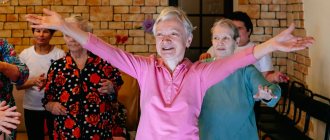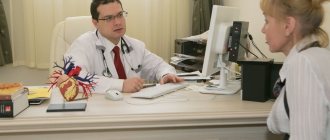First aid for acute heart failure
Acute heart failure (AHF) is a severe pathological condition that develops in patients with various heart diseases and hypertension. This is one of the most common reasons for calling an ambulance and hospitalization of patients, as well as mortality in our country and around the world.
The main manifestations (symptoms) of acute heart failure are:
- Heavy, frequent (more than 24 per minute) noisy breathing - shortness of breath, sometimes reaching the level of suffocation, with predominant difficulty in inhaling and a clear increase in shortness of breath and cough in a horizontal position. A sitting position or a lying position with the head of the body raised high alleviates the patient's condition.
- Wet, squelching wheezing/sounds are often heard when breathing,
- interrupted by coughing, in the terminal stage the breathing takes on a bubbling character, with the appearance of foam at the mouth.
- The patient is characterized by a sitting posture with straight arms resting on the knees.
Acute heart failure can develop very quickly and lead to the death of the patient within 30–60 minutes. In most cases, 6–12 or more hours pass from the first clinical signs to severe manifestations of AHF, but without medical care, the absolute majority of patients with AHF die.
First aid measures
If the above symptoms of AHF appear in patients with hypertension or heart disease (but not lungs or bronchi), it is necessary:
- Call emergency medical assistance.
- Place the patient in a sitting position, preferably in a chair with armrests, on
- which he can lean on and engage the intercostal muscles in the act of breathing.
- Provide physical and psycho-emotional peace and fresh air.
- Place your feet in a large container (basin, tank, bucket, etc.) with hot water.
- In extremely severe cases, tourniquets are applied to the legs in the groin area, compressing the superficial veins, but not the deep arteries, which reduces blood flow to the heart and thereby facilitates its work.
- If there is experience in the use of nitroglycerin in a patient or a person providing first aid, it is prescribed in a dose of 0.4 (0.5) mg (inhalation into the oral cavity is carried out under the root of the tongue, the tablet/capsule is placed under the tongue, the capsule must first be bitten, do not swallow). If the patient’s well-being improves after using nitroglycerin, it is reapplied every 5–10 minutes until the emergency medical team arrives. If there is no improvement in the patient's well-being after using nitroglycerin, it is no longer used.
Attention! A patient with AHF is strictly forbidden to get up, walk, smoke, drink water and take liquid food until special permission from the doctor. You should not take nitroglycerin if your blood pressure is less than 100 mmHg. Art., with severe headache, dizziness, acute impairment of vision, speech or coordination of movements.
All patients with hypertension or heart disease with shortness of breath and swelling in the legs should discuss with their doctor what medications should be taken if AHF develops, clearly write down their names, dosage and time sequence (algorithm) for taking them, and also check with the doctor if what manifestations of the disease require urgent medical attention. Each such patient needs to create an individual first aid kit for AHF and constantly have it with him.
Source: Boytsov S. A., Ipatov P. V., Kalinina A. M., Vylegzhanin S. V., Gambaryan M. G., Eganyan R. A., Zubkova I. I., Ponomareva E. G., Solovyova S. B., “Organization of clinical examination and preventive medical examinations of the adult population.” Guidelines. 2nd edition with additions and clarifications, M., 2013.
All articles
Development mechanism
Regardless of the disease that provoked acute heart failure, the mechanism of development of the pathological condition is approximately the same: the cardiac output and blood flow into the arterial system sharply decrease. The clinical picture is quite similar to acute vascular insufficiency.
The development of AHF begins with a pathological process that reduces the contractility of the muscles of one of the ventricles, or reduces the elasticity of the valves separating the atrium and ventricle. Weak muscle contraction pushes blood into the artery in a smaller volume, while some blood remains in the ventricle itself, and without complete contraction, the flow of new blood from the atrium also slows down.
In the case of chronic heart failure and mitral valve prolapse, the problem is solved due to compensatory mechanisms and the ability of the heart to adapt. In a situation of acute deficiency, the body does not have time to adapt, which increases the risk of death.
Prevention
A patient who has suffered acute heart failure is almost always forced to take maintenance medications for life. No more than half of the patients exceed the five-year survival threshold; subsequently, life expectancy depends on the severity of the condition suffered, general health, and correct lifestyle.
To avoid acute heart failure and all the risks that accompany it, it is necessary to take preventive measures:
- lead a healthy lifestyle;
- to walk alot;
- coordinate your diet and diet with a specialist;
- exclude alcohol, tobacco, stimulants;
- Avoid stress as much as possible;
- Learn calming and relaxing breathing techniques.
Social activity in a positive way will be beneficial: hobbies, communication with friends and family, participation in exhibitions, performances, travel. An optimal balance between activity and quiet rest will also reduce the risks of developing heart failure.
Diagnostics
Doctors in specialized cardiology departments and resuscitators have too little time to carry out a full diagnosis, but in the process of stabilizing the patient’s condition they conduct the following studies:
- ECG for diagnosing heart rhythm disturbances.
- EchoCG to identify areas of organic damage.
- Chest X-ray.
- UAC urgent
- Determination of oxygen saturation in arterial blood to establish the level of hypoxia.
Having achieved complete stabilization of the patient’s condition, more in-depth studies are carried out:
- MRI and CT of the heart, cardiac structures, brain, adrenal glands.
- Angiography of large vessels
- Ultrasound to measure blood flow speed
- Radioisotope research
Invasive tests may be performed to clarify the diagnosis. Any load tests are strictly prohibited.
Consequences of OSN
Acute heart failure is dangerous in itself, and also has a number of complications, often fatal:
- Cardiogenic shock. Mortality is close to 100%. Occurs when blood pressure drops critically. Even if the patient survives, the average life expectancy is about 2 years with constant monitoring by a cardiologist.
- Pulmonary edema with the possibility of asphyxia and inability to breathe independently. It occurs due to impaired gas exchange and venous outflow. With complete removal of fluid from the lungs and relief of all signs of intoxication, there is a chance of survival for the patient.
- Myocardial infarction increases the likelihood of death by 30-40%. Occurs due to acute disruption of blood supply to cardiac structures
- Stroke. Characteristic damage to cerebral structures due to malnutrition. Accompanied by the death of active neurons in the affected area.
Treatment
Surgical intervention for acute heart failure is ineffective and is indicated only in rare cases, therefore the scheme for stopping and treating the condition is completely dependent on medications.
Stabilization of the patient's condition
To relieve the acute phase of heart failure it is necessary:
- Stop the panic attack and anesthetize the patient with drotaverine and paracetamol. Narcotic painkillers are indicated only in the most extreme cases, as they increase the risk of death and require careful dosing.
- Restore contractility of both ventricles and cardiac activity in general. Dopamine drugs and cardiac glycosides are used. Prohibited for proven heart attack.
- Unload the heart to restore normal blood flow to the minimum acceptable level. It is possible to use diuretics, organic nitrates, beta blockers, as well as tranquilizers and phenobarbital in precisely calculated dosages.
As a rule, these measures allow you to stabilize the patient’s condition and restore cardiac activity.
Maintenance therapy
The following are used as maintenance therapy:
- Corticosteroids intravenously for up to 4 weeks.
- Bronchodilators.
- Angioprotectors.
- Antithrombic drugs that help restore the rheological properties of blood. The optimal choice is Fasostabil, which blocks the synthesis of thromboxane A2 and prevents the formation of venous blood clots.
Features of treatment of AHF
If help was provided to the patient in a timely manner and the attack was stopped, he is transported to the intensive care unit. Treatment of patients with heart failure is aimed at maintaining the general condition of the body, eliminating dyspnea and signs of an attack. For this purpose, the following is carried out:
- elimination of bronchospasm using intravenous injections of aminophylline;
- analgesic therapy that allows you to quickly and effectively relieve pain;
- oxygen therapy, which involves the use of inhalers and oxygen masks to bring air into the lungs;
- infusion treatment, including drip or jet administration of medications to neutralize pathology and its consequences.
To prevent overload on the heart muscle, doctors use drugs that lower blood pressure and normalize the heart rate. Symptoms of heart failure are eliminated by intravenous administration of glycosides, and to avoid the appearance of edema, the patient is prescribed diuretics.
If conservative treatment of a patient with AHF carried out in a hospital setting does not bring a positive result, surgery is performed. The patient is fitted with a pacemaker, which maintains normal blood supply to the myocardium and filling of the ventricles with blood.
First aid for sudden death (tips for eyewitnesses)
Most often, sudden death occurs due to cessation of cardiac activity.
The main signs (symptoms) of sudden death:
• Sudden loss of consciousness, often accompanied by agonal movements (a standing or sitting person falls, convulsive muscle tension, involuntary urination and defecation are often observed; a lying person sometimes makes a convulsive attempt to sit up or turn on his side).
• Sudden complete cessation of breathing, often after a short period (5-10 seconds) of agonal pseudobreathing: the patient makes wheezing and/or gurgling sounds, sometimes similar to a convulsive attempt to say something.
Classification
In addition to acute and chronic heart failure, there are:
- Left ventricular AHF, which occurs in 60-71% of cases, with timely medical care, about 70% of patients survive.
- Right ventricular AHF, responsible for 20-25% of cases, timely medical and pre-medical care ensures survival of 85% of patients.
- Biventricular, or bilateral AHF, which is diagnosed in 10% of patients and has an almost 100% probability of death. In rare cases, exit from the acute phase guarantees the patient's death within 2-3 years, even with full pharmacological support.
The rehabilitation period for any form of acute heart failure lasts at least six months, and surviving patients require lifelong medication.
Algorithm of actions in case of cardiac arrest
First aid for cardiac arrest:
- lay the patient on a flat, hard surface with his back, place a cushion formed from improvised means under his head;
- place hands folded like a butterfly on the lower third of the person’s sternum and perform jerking movements at a speed of 60-65 times per minute. They must be very strong
(professional resuscitators often break patients’ ribs during chest compressions. But in terms of bringing a person back to life, this is a justifiable injury);
- if possible, a second person performs artificial respiration, but if there is only one resuscitator, you should alternate 1 breath for 5-6 pushes;
- After a while, you need to evaluate the effectiveness of actions. With positive dynamics, a pulse appears in the carotid and peripheral arteries, the skin acquires a “live” pink tint, pressure rises, and the ability to breathe independently is restored.
Even if there is no effectiveness, it is necessary to continue the measures until the team arrives; this will preserve the vital functions of the body and prevent the development of irreversible consequences caused by brain hypoxia.








